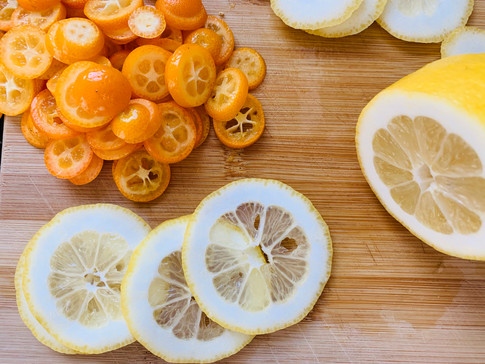Winter in Germany is Horrible But at Least They Have Kumquats
- christinaspittler
- Feb 22, 2019
- 7 min read
I know I've mentioned more than once that it is grey and miserable here in Berlin during the winter but that's because it is grey and miserable here in Berlin during the winter. I'm not too bent out of shape over it because being pregnant has made me pretty anti-social anyway so filling my weekends with cozying up on the couch with a good book or a fun cooking project while the weather outside remains tortured feels totally satisfying. It's not like the weather here is even that bad— I'm talking temperatures hovering around freezing with a bit of rain or some snow that never sticks. It could certainly be worse. But I suppose my chief complaint is the grey. Or, perhaps more accurately, it's the monosyllabic, bleak, communist feel of a dark, wet city populated by blocky, ominous, cement buildings and spindly, naked trees that all look straight out of a Tim Burton movie. That's my main issue. But, I recently discovered a bit of light in this slate-colored metropolis and it has perked me up a bit. Shockingly, on display at all the local grocery stores and markets this winter, are beautiful, adorable, golden kumquats for sale. Not to get all Martha Stewart on you, but that's a really great thing.
Kumquats are perfect little citrus fruits with a sweet skin and a very sour flesh that you must consume in one mouthful in order to not be overwhelmed by either attribute. The two components balance each other out perfectly, super sweet and super sour. From what I can tell, the kumquats all over Berlin are from sunny Spain, as are most of the citrus fruits one can buy here. China and South Africa are also top growers and surprisingly, the plant is native to South Asia. Kumquats are also just cute, fun to say, and I love their sherbet orange color.

My sister can take credit for introducing them to me one day when we were visiting my grandparents in southern California. Like most kids visiting their grandparents, we were expected to be on our best behavior and this was always a bit stressful for me. At the time of this trip, I had already comfortably assumed the role as The Goofy One so I didn't do the whole serious thing very well, not to mention that I hated sitting still and I rarely had brushed hair. I was probably 80% monkey back then. One morning, while I was probably either robotically drying dishes from our formal sit-down breakfast at the breakfast table (yes, there was a BREAKFAST TABLE at this house) or maybe stiffly sitting in an antique chair reading a book, most likely soiling it with my thrice-worn hand-me-downs, trying to give off the impression that I was at least a well-read monkey, my sister whispered to me to go with her outside. Thrilled to not be doing whichever one of those things I was doing, I followed her out. It was warm and sunny outside and she brought me to a large potted plant near the front door. It was as tall as I was and had these weird orange fruits growing on it. My sister picked one fruit off the plant and handed it to me and said "eat it". Now, I had fallen for this "eat it" trick once before when my older cousin presented a palm full of colorful bath beads to my six-year-old self and told me to eat them. He said they were candy. As older people know everything, naturally I popped one in my mouth. He erupted into maniacal laughter and I was left to combine his curious reaction with the poisonous taste that had overwhelmed my insides, quickly coming to the conclusion that he had just fed me something that was not in fact candy but actually soap. Never again was I going to trust my elders and blindly just "eat it". My suspicion must have been clear on my face as my sister picked another fruit from the plant and popped it into her mouth in solidarity (I think she was in on the bath bead incident). Following suit, I chomped into the little orange ball and was pleasantly surprised by what I tasted. So much flavor in such a little package! What was this tangy little nugget?! My sister smiled that 'I-told-you-so' smile, knowing she had just shown me something awesome. So that was the first time I tasted a kumquat and I have never forgotten it (and, unfortunately, same goes for the bath bead incident).

My favorite way to enjoy kumquats is in a marmalade. Something about the chewy texture of the rind and that perfect floral sweet and tart balance really gets me. Having kumquats here in Berlin is like opening the blinds in the dark of morning to reveal a bright, blue sky outside. It is California and I love it. In order to hold on to this fleeting glimmer of light in my currently-mostly-grey life, I figured it would be smart to cook a big batch of kumquat jam to remind me of home and keep the Seasonal Affective Disorder at bay. I also had a birthday cake project lined up and thought it could also use a pop of candied kumquat slices as part of the decor. Since I've been proactively quarantining myself in my kitchen lately, these two kumquat projects seemed like the perfect weekend activity.

First things first for both recipes: the kumquats need a rinse. In both cases, you’re eating the peel here so be sure to give them all a little attention under the water. Next, they must be sliced. The fruit slices that are not so pretty will be cooked down into marmalade and the pretty slices that are in tact and recognizable as complete rounds will be candied. So, preferably with a recently sharpened knife (Thanks Uncle Craig!), slice each kumquat crosswise into 1/8” thin coins. This is easier said than done as when you approach the center of the fruit you will most likely encounter seeds and they need to be picked/squeezed/popped out. Then you will be left with slices of kumquats that have large holes in them. These go in the ‘marmalade’ bowl and the prettier, smaller slices that don’t have holes in them go in the ‘candying’ bowl. David Leibovitz says to hold on to the seeds because when added to the marmalade they add more pectin, but I didn’t have any cheesecloth so I donated my seeds to the compost bin. For my candying project, I also threw in a few, thin slices of lemon. The rest of the lemon I juiced and chopped up to add to the marmalade but keep it separate from the kumquats for now.
To candy the kumquat slices: Make a simple syrup in a small pot by bringing equal parts (by weight, not volume) sugar and water to a boil. Boil just until the sugar is dissolves and turn off the heat. Add the pretty kumquat slices (or whatever citrus slices you're using) to the hot syrup and gently stir to make sure each slice gets a good dunk in the liquid. Put the pot over high heat and watch carefully as the liquid comes back to a simmer. As soon as the liquid has come to a simmer, again turn the heat off and remove the pot from the heat. Let the hot syrup and the kumquats sit uncovered for 30 minutes. After thirty minutes, repeat the process again, being careful not to the let the syrup reach a rolling boil as this could break up the perfect citrus slices (they are fragile). Again, let the mixture sit for 30 minutes. After 30 minutes, repeat the process one last time. You will see that the white pith becomes more translucent with every round of this which is how you know the process is working. Remove the pot one last time from the heat, cover, and let the hot syrup sit until the contents are at room temperature or, better yet, overnight.
After the syrup is totally cool, or the next day, drain the slices carefully with a small sieve or a spider and lay them out evenly over a lightly oiled wire rack. You may want to place a sheet pan or parchment paper under the rack to catch any sticky drips. Set the rack in a warm and dry location of the house, or if you live in Europe, on a radiator, to dry for one to two days, flipping them over after the first 24 hours. If you’re in a hurry you can dry the slices in the oven at the lowest temperature with a fan setting blowing, checking and turning them every 30 minutes until they have reached a mostly dried but still chewy texture. You can reuse the simple syrup for future citrus candying projects, as a simple syrup in cocktails, or in sorbet making. Be sure to strain it and store it in the fridge or freezer.

To make kumquat marmalade: Add the less-than-perfect sliced kumquats and some chopped up lemon to a large pot. Add just enough water to the pot to cover the fruit, no exact measurements needed yet. Bring mixture to a boil over high heat and cook for about three minutes. Pour mixture into a colander or sieve and drain the water from the fruit. This step removes a lot of the bitterness from the peel. Next, add the softened fruit back into the now empty pot and add lemon juice, sugar, and water. The ratio I used here was 3 parts fruit to 2 parts sugar, adding, again, enough water to cover the fruit and sugar. Bring mixture to a boil over high heat then reduce heat to medium and continue cooking until marmalade has reached a temperature of 218°F degrees.


If you want a stiffer marmalade, keep cooking until 222°F and for a thinner marmalade, or something like a sauce, 216°F might be better. You can test the doneness by spooning a small blob onto a cold plate and moving it around with your finger (carefully) to investigate what the texture will be like when cooler. Remember it will always be more fluid and loose when it is hot. Spoon marmalade into jars and let it sit out at room temperature to cool before storing in the fridge. This type of marmalade can be kept in your fridge for two to three weeks (this method doesn't make shelf-stable marmalade).

I ended my weekend by attending a birthday party of a friend and used both the marmalade and the candied kumquats to decorate her cake. I used a thin layer of marmalade to first create a ring or base in which I placed berries. Then, after arranging blueberries, raspberries, and red currants (Johannisbeeren in German) decoratively in the marmalade, I carefully used a few well-placed candied kumquat slices and triangles of candied lemon slices to finish the look. In the end, I was quite pleased with the result and I still have plenty of marmalade left to share (and eat myself).

Spread on a slab of toasted sourdough bread, this kumquat marmalade is currently acting as my sun, my warmth, my California as I continue enduring my first Berlin winter. And while it's not exactly the same as seeing the sun, blue skies, or green trees on a more regular basis, I'm thankful it exists here at all and plan to savor every last bite.





























Comments